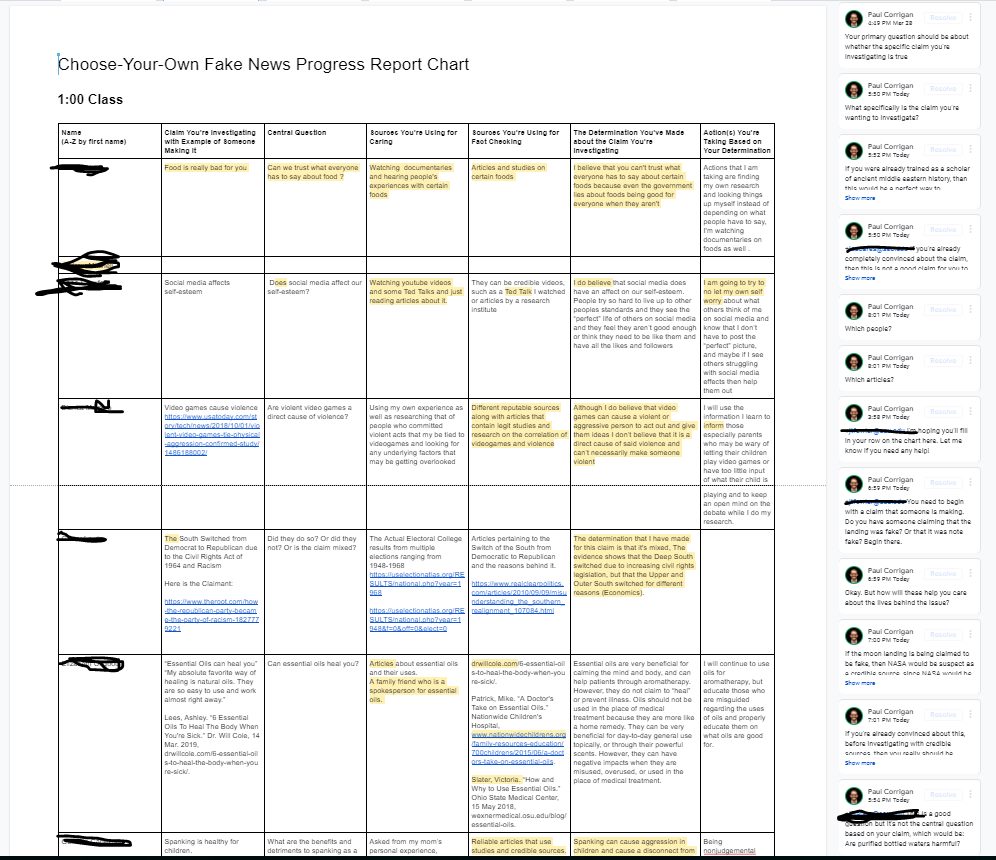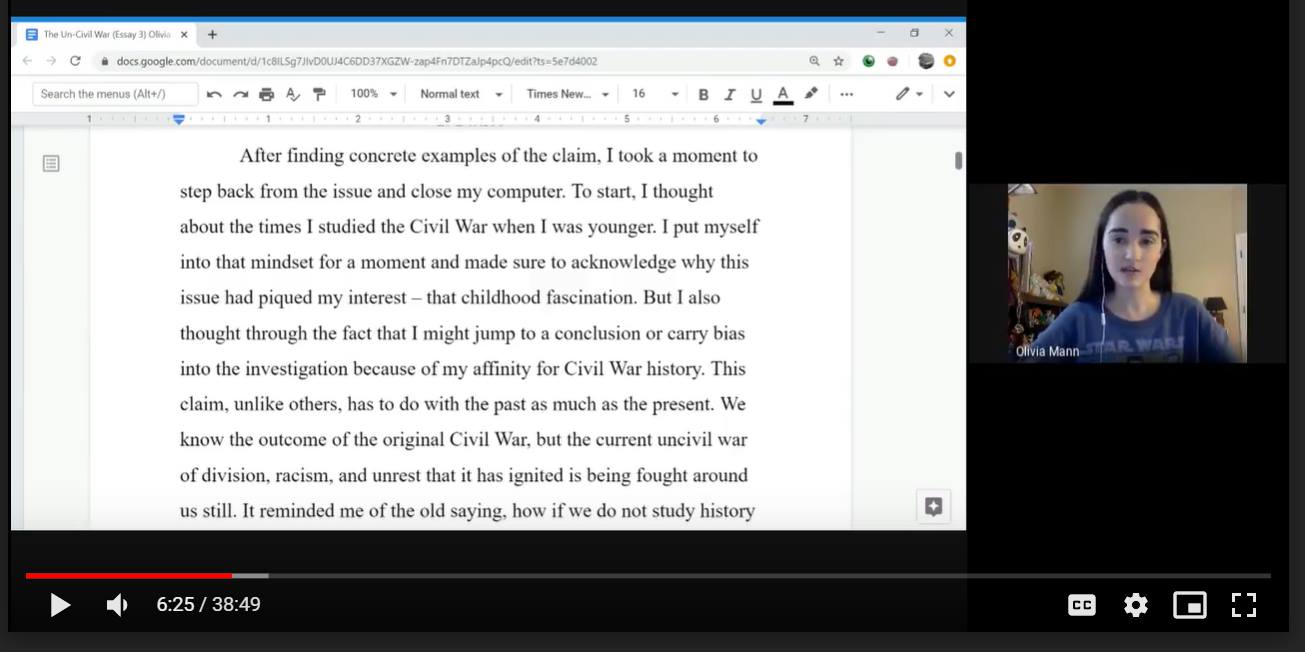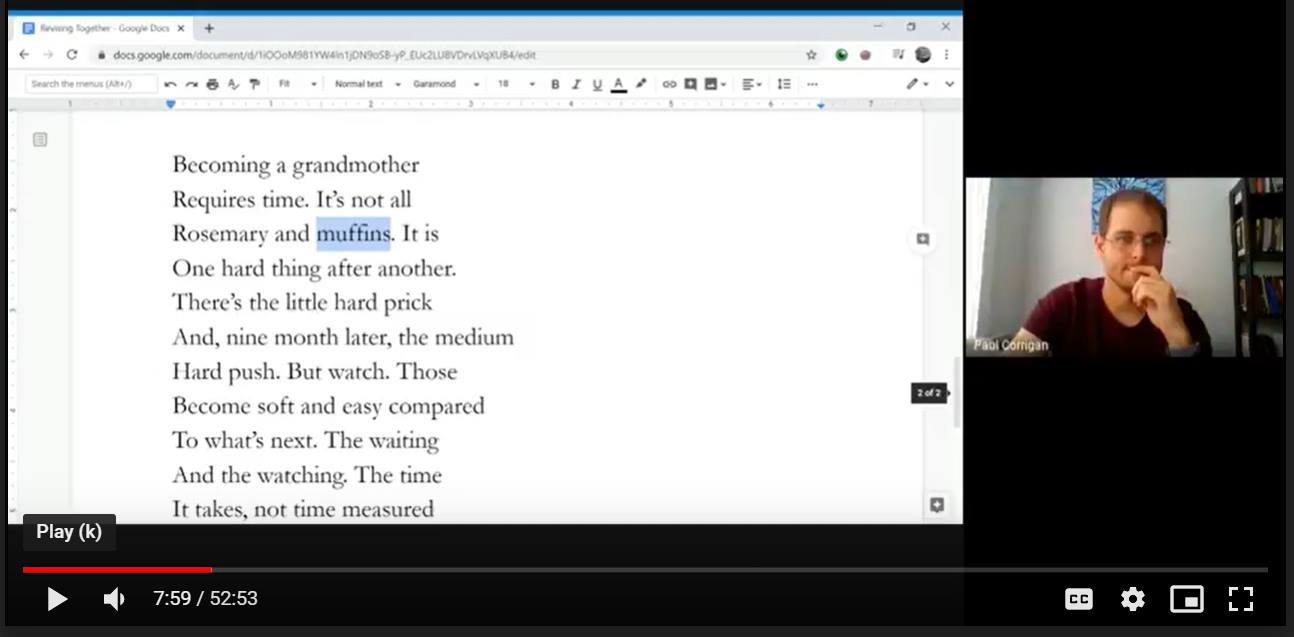Three Strategies for Teaching Writing Remotely During the Pandemic
As the CAT has been recommending writing assignments as alternatives to closed-book exams, we thought it would be helpful to share some advice about teaching writing remotely. Toward that end, today’s guest post is by Paul T. Corrigan, Associate Professor of English at Southeastern University. Paul is a friend and expert pedagogue who has been chronicling his experiments over social media these past few weeks. When I saw what he was up to, I asked him to share with the Wake Forest community.
Creating emergency innovations the past few weeks, to teach writing remotely during the pandemic, I have followed the dual mandates of keeping things as simple as possible while also maintaining human contact with students as they work on their writing. Some of my efforts have been less than successful—such as when half or fewer of my students signed up or showed up for the ten-minute phone/video calls I made “mandatory” so we could talk one-to-one about their essays in progress. But others, like the three strategies I share below, have worked well enough that I will want to continue using them when we all return (🤞) to teaching in person. I think of these strategies as consolation pedagogies. Not silver linings in a global catastrophe. Not pros to weigh against the cons of teaching remotely. Not justifications for keeping courses online permanently. Just a few ways of teaching I’ve been forced to devise that offer some pedagogical consolation amidst the pedagogical desolation.
Research Essay Progress Report Chart
My school jumped to remote instruction just at the moment students in my English Composition II courses were about to begin the final research essay—the project toward which the whole course builds. Ordinarly, I would have the students complete bite-sized portions of the researching and writing process and bring their work to class to share and discuss with classmates and with me. In fact, most of the rest of the semester would be dedicated to exactly this—all of the students continually writing and sharing in and out of class until the major projects were completed. In this arrangement, I could try to get a sense of where my students were in the process, whether they were right on track or veering off a bit and give them impromptu feedback and guidance right there in person. Doing that is more timely than waiting until students turn in a full or final draft to give them feedback and more feasible than trying to grade and write comments on daily homework assignments along the way. But with that strategy no longer possible, what could I do?
I created in a Google Doc the “progress report” chart shown in the image above and shared it, with editing privileges, with all of the students in the composition class. Each student has their own row and each column gives space to a different key component of the essay (the claim they’re investigating, the sources they’re using, etc.). As the students update the chart with brief summaries of what they’re doing for each component, I leave feedback, while tagging the students so they receive notice of my comments. (In Google Docs, tagging folks is a simple matter of including the @ symbol followed by the recipient’s email address in the commenting feature, which can be accessed by highlighting some text in the doc and then hitting CTRL+ALT+M.) I also encourage the students to glance at the feedback I leave their classmates, in case it’s helpful too, much as they might hear feedback about others’ work if we were discussing their writing during class time, as we would be if we were still meeting face to face. Furthermore, students can respond to my comments and we can even have a brief conversation about their work right there on the spot in the document. Having all of the students’ projects present at once in compressed form makes it really easy to see where everyone is. I can see at once who needs nothing more from me, who needs a nudge in the right direction, who has fallen behind or off the grid altogether and respond accordingly.
Discussion of a Sample Research Essay
Teaching composition in person, while students are working on their own research essays, I usually bring to class copies of a sample student essay for us all to read together and discuss. We look at the ways the essay meets or does not meet the project’s aims and parameters. I give students a chart with the criteria for the assignment and ask them to assess the essay themselves and then we all discuss the assessments. How do the general criteria apply to the specific details of the sample? The idea is that students will get both a concrete example of what a successful project could look like and firsthand experience examining an essay in light of the criteria—to, ideally, take back and apply to their own drafts. I consider the interactive portion of this activity essential. I’m not just giving students an example; we are working through it together. Could those dynamics be reproduced remotely? I came up with an alternative that’s not quite the same but not too shabby either.
Using Google Meet and Google Docs, I recorded a video discussion of a sample essay, between myself and the student writer, Olivia Mann, who had written it the semester before. The idea is to give students the text of the essay, the voice, face, and experience of the writer behind it, and my commentary on it as the teacher. Hopefully this will be a compelling way for students to get a better understanding not only of what I am looking for but also what they are capable of. With her permission, I’ve shared the video here. Simultaneously, to make the resources available in multiple formats, I also simply shared with students that same essay in a Google Doc with my comments on key moments.
Live Revision Workshopping a Poem
A third strategy comes from a poetry writing class. Teaching the course in person, after a couple weeks of workshop where all of the student poets receive feedback on their poems from the class, I usually give students a chance to actually revise their poems with me live during class. We already use Google Docs for this activity. A student volunteer and I work on the poem together, talking through the revisions along the way. I would ask questions, make suggestions. We would fiddle around with the actual text of the poem, trying out lines one way then another, reading them aloud, deciding which the poet liked better, and so forth. The intended benefit of the activity was not just for the individual students who volunteered to revise in front of their classmates but also for the whole class watching revision happen in real time. Of the three strategies here, this one transitioned online the most seamlessly.
My friend and fellow poet Anna Cotton volunteered to revise poems of ours together, as we have done countless times over the years. But this time we recorded our revising sessions through Google Meet, precisely as in creating the video with my student (in the previous strategy) except instead of just discussing the text on the screen, we worked on the text on the screen. Students watching the video on their own time would see the poems unfold and shift and change (and often enough change back before changing again, as revision goes) right before their eyes, while also hearing our discussion and deliberation of these changes as we went. The video of us revising my poem “Grandma’s Watch” is here and the one of us revising Anna’s poem “Scherezade and Zorro Cheered for Us” is here. Finally, I invited any students who wanted to revise their own poems with me in the same way to schedule an appointment to do so.
Strategies in Progress
If these strategies are “consolation pedagogies,” as I’ve called them, they are also very much strategies in progress. I share in the spirit of what Nancy Chick, Jennifer Friberg, and Lee Skallerup Bessette call pedagogical triage. These are innovations unfolding under the heat of immediate necessity. They are not methods I have honed over time or grounded in data and theory but rather things I’m trying out and sharing as I try them—as many educators, thankfully, have been doing during this pandemic. Even so, I want to already start thinking about limitations and about revisions going forward.
In How Humans Learn: The Science and Stories of Successful College Teaching, Josh Eyler, summarizing research on the importance of “sociality” in human learning, concludes the following about the drawbacks of regular online courses: “it is impossible to discount the educational value of being together in the same place and at the same moment, responding to each other’s verbal and nonverbal cues, building knowledge not individually but as a community” (p. 111). If these dynamics are threatened under the usual conditions of teaching online, then they must be all the more at risk with courses thrown online part way through being taught and taken.
None of the strategies I’ve devised and shared here fully replace any of those dynamics. But I suspect that they lean back in the right direction, capturing some aspects of being present together. The progress report chart allows timely give and take in a communal space. The video of a discussion of the sample essay allows for verbal and nonverbal cues and response. And the videos of revision of poems demonstrates building knowledge not just individually but communally. Not bad consolation prizes under the circumstances, valuable enough, in fact, that I would like to use these same strategies in the future as supplements when teaching in person.
All the same, these strategies stand in need of refining. “Not bad for thrown together in an emergency” is not the bar I’m reaching for. I know, for instance, that the videos I created are far longer than most students will likely watch and that I have shared them with my students without building in any activities or accountability for students to actually engage with the material. Those are limitations I could address going forward.
Finally, I am aware and concerned that all three resources might not be as accessible as possible for all students. For instance, those who use a screen reader or who do not have reliable high speed internet or a quiet place to watch a video might face unfair challenges in accessing these materials. I am sure there are other factors I have not yet considered that affect access in other ways as well. So I intend to continue thinking about making these and other resources accessible, and welcome suggestions or feedback on that front. In difficult circumstances for teaching and learning, for us and our students, accessibility matters more than ever.
Subscribe
Receive CAT remote teaching updates in your inbox.




